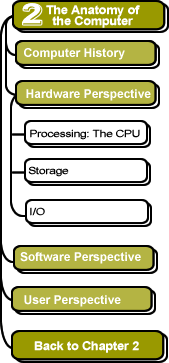

|
How does memory store information?
The memory system can only store 1s and 0s. Thus all information that is stored in the computer memory must be modeled as a binary value. Numbers are the first type of information represented digitally in computers. For example, the number 5 is 00000101 in (8-bit) binary. Note that while humans can imagine an infinite variety of numbers, computers have a limited space for numbers. For example, a 32-bit register can hold any whole number between 0 and 4,294,967,295 (over four billion). This range works for many math problems, but it won't work for everything. Floating-point values, such as 4.25, can also be represented with binary numbers. Most computers use a particular format, called "IEEE floating-point" to determine how the bits are arranged. This format still has a maximum size number that can be represented and also a minimum size. It provides one special pattern to represent zero and another special pattern to represent infinity. Any result that is calculated larger than the maximum value will automatically be represented as the infinity value.
Soon after the development of the first computer, the idea of storing the program itself in memory was discovered. So for example, the ADD instruction might be represented as 00000110, and the SUBTRACT instruction might be represented as 0000101. Note that those same patterns of 1s and 0s could also represent integer (whole) numbers, so the CPU must properly interpret the binary values (which it will do if the program software is written correctly), since sometimes they can represent actual numbers and other times they can represent commands or instructions.
Modern computer software represents a great variety of information in binary, including colors, images, sounds, letters, words, maps, stock prices, pictures, weather patterns, names, and more. You can learn about the details of representing and modeling information digitally in the chapter entitled "Modeling Reality with Computers." The main idea to understand at this point is that the representation will always have some limits, such as a maximum size of number, or a limit on the accuracy of a measurement, or a bound on the number of colors.
Digitally represented materials can also be duplicated and distributed very easily. This has motivated an important ethical debate on when materials can legally and ethically be duplicated. You can learn more about the details of this debate in chapter 6.
![]()
![]()
These pages were written by Steven H. VanderLeest and Jeffrey Nyhoff and edited by Nancy Zylstra
©2005 Calvin University (formerly Calvin College), All Rights Reserved
If you encounter technical errors, contact computing@calvin.edu.